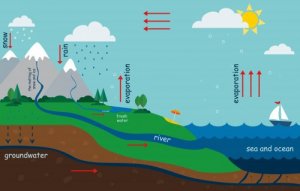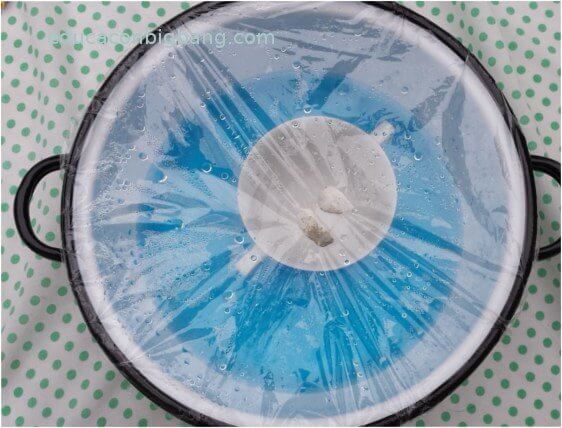How to Explain the Water Cycle to Children


Written and verified by the psychologist María Alejandra Castro Arbeláez
What makes water change from one state to another? We’ll try to answer this question in a fun and entertaining way to explain the water cycle to children.
Water is an essential element on Earth: 75% of the land surface is covered with water, but only 3.5% of that amount is fresh water. In addition, 69% of that fresh water is in the form of ice. The remaining 31% is liquid in rivers and underground. You can also find water circulating in the atmosphere as a gas.
What is the water cycle?
Water is a molecule that consists of two hydrogen atoms and one atom of oxygen. It’s tasteless, colorless and odorless. Also, water can occur in three states: liquid (the water we drink), solid (ice cubes that keep us cool in the summer) or gas (water vapor that travels into the atmosphere.)
Water moves through these three states in what we call the water cycle. The engine responsible for this movement is the sun, which evaporates liquid water from seas and lakes into the atmosphere. There, with the help of gravity, wind and temperature changes, water will go back to Earth’s surface in the form of rain, snow or hail.
People and living beings also contribute to this cycle. We drink water, then expel it later.
Explaining the water cycle to children
The hydrosphere is the set of all water on Earth. In addition to the liquid water in seas, oceans and rivers, glaciers are also an important part. These are the layers of ice that float in the oceans.
The liquid water in seas, lakes or rivers evaporates because of the heat that the sun produces. Then, the evaporated water particles rise and condense in the atmosphere. There, the water vapor cools and condenses into small water droplets that form clouds.
Thanks to the wind, the clouds move to colder areas where it falls in the form of rain, snow or hail. This is how water goes back to Earth. The water that has fallen through the mountains will flow to rivers or become part of the groundwater.
Experiment to explain the water cycle to children
Materials
- Two bowls, preferably glass. If not, you can use plastic bowls as long as they’re transparent.
- Food coloring
- A teaspoon of salt
- Transparent plastic wrap
- An apple
Process
- Heat the water in the container slightly, and add the dye and salt. That way, you’ll help the salt dissolve in the water.
- Once the salt is dissolved, pour the mixture into a larger transparent bowl. In the center, place another, smaller bowl.
- Cover it with the plastic wrap, and put an apple on top in the center to weigh it down. Then, place both bowls in the window where they’re in the sun.

- After a little while, you’ll see some water on the inside of the plastic wrap. It will be evaporated and condensed water.
- Press in the center of the film in order to concentrate the drops of water so they fall into the smaller bowl.
Results of the water cycle experiment
When heated, the water evaporates. Then, when it reaches the plastic, it can’t go up any higher, like when it reaches the atmosphere. Next, it will cool and start to form water drops that you can see on your plastic wrap. In nature, this is how clouds form.
If you test the water that precipitated in the little bowl, you’ll see that it’s colorless and tasteless, like rainwater.
I hope you have fun doing this simple experiment to explain the water cycle to children.
What makes water change from one state to another? We’ll try to answer this question in a fun and entertaining way to explain the water cycle to children.
Water is an essential element on Earth: 75% of the land surface is covered with water, but only 3.5% of that amount is fresh water. In addition, 69% of that fresh water is in the form of ice. The remaining 31% is liquid in rivers and underground. You can also find water circulating in the atmosphere as a gas.
What is the water cycle?
Water is a molecule that consists of two hydrogen atoms and one atom of oxygen. It’s tasteless, colorless and odorless. Also, water can occur in three states: liquid (the water we drink), solid (ice cubes that keep us cool in the summer) or gas (water vapor that travels into the atmosphere.)
Water moves through these three states in what we call the water cycle. The engine responsible for this movement is the sun, which evaporates liquid water from seas and lakes into the atmosphere. There, with the help of gravity, wind and temperature changes, water will go back to Earth’s surface in the form of rain, snow or hail.
People and living beings also contribute to this cycle. We drink water, then expel it later.
Explaining the water cycle to children
The hydrosphere is the set of all water on Earth. In addition to the liquid water in seas, oceans and rivers, glaciers are also an important part. These are the layers of ice that float in the oceans.
The liquid water in seas, lakes or rivers evaporates because of the heat that the sun produces. Then, the evaporated water particles rise and condense in the atmosphere. There, the water vapor cools and condenses into small water droplets that form clouds.
Thanks to the wind, the clouds move to colder areas where it falls in the form of rain, snow or hail. This is how water goes back to Earth. The water that has fallen through the mountains will flow to rivers or become part of the groundwater.
Experiment to explain the water cycle to children
Materials
- Two bowls, preferably glass. If not, you can use plastic bowls as long as they’re transparent.
- Food coloring
- A teaspoon of salt
- Transparent plastic wrap
- An apple
Process
- Heat the water in the container slightly, and add the dye and salt. That way, you’ll help the salt dissolve in the water.
- Once the salt is dissolved, pour the mixture into a larger transparent bowl. In the center, place another, smaller bowl.
- Cover it with the plastic wrap, and put an apple on top in the center to weigh it down. Then, place both bowls in the window where they’re in the sun.

- After a little while, you’ll see some water on the inside of the plastic wrap. It will be evaporated and condensed water.
- Press in the center of the film in order to concentrate the drops of water so they fall into the smaller bowl.
Results of the water cycle experiment
When heated, the water evaporates. Then, when it reaches the plastic, it can’t go up any higher, like when it reaches the atmosphere. Next, it will cool and start to form water drops that you can see on your plastic wrap. In nature, this is how clouds form.
If you test the water that precipitated in the little bowl, you’ll see that it’s colorless and tasteless, like rainwater.
I hope you have fun doing this simple experiment to explain the water cycle to children.
All cited sources were thoroughly reviewed by our team to ensure their quality, reliability, currency, and validity. The bibliography of this article was considered reliable and of academic or scientific accuracy.
- Amorós, M. (2014) Ciclo del agua [artículo en blog]. Recuperado de: rimasdecolores.blogspot.com
- Santillana Educación, S.L. (2015). Ciencias de la naturaleza: 4º de primaria
- Vera, N. y Camilloni, I. (2007) El ciclo del agua [artículo en web]. Recuperado de: www.bnm.me.gov.ar
This text is provided for informational purposes only and does not replace consultation with a professional. If in doubt, consult your specialist.








